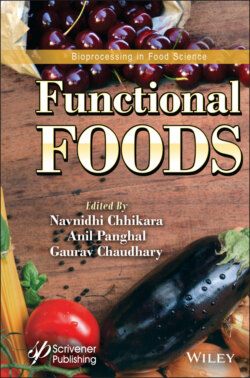Читать книгу Functional Foods - Группа авторов - Страница 17
1.3 Classification of Functional Foods
ОглавлениеFunctional foods include a huge range of foods like whole foods along with fortified, enriched or enhanced foods, probiotics and designer foods. Functional food has been categorized as conventional foods, modified foods and functional food ingredients. Another way of classification suggest that functional foods are 1st, 2nd and 3rd generation foods which includes supplements, whole foods and novel foods respectively.
Conventional foods: Whole foods that are naturally occurring and possess beneficial effect on human physiological conditions are categorized in conventional foods. E.g. Whole fruits, vegetables, grains, nuts, seeds, legumes, dairy, meats, and sea foods. Such foods contain an abundant amount of numerous bioactive compounds inherently and have been associated with good health.
Probiotics are the selective, viable microbial cell administered in adequate amount to provide numerous health promoting benefits along with basic nutrition [13]. These viable microbial dietary supplements exhibit beneficially affects in the host through its effects in the intestinal tract”. On the other hand, functional food term is used to describe nutrients that have positive effects on physiological processes beyond the traditional nutritional effect. Probiotics could enhance physiologic functions benefiting health or preventing disease and be classified as functional food ingredients [14]. It is a novel concept and good health can be achieved by nurturing the body’s naturally occurring microorganisms and ensuring the proper functioning of the digestive tract. Lactobacillus, Bifidum and Leuconostoc bacteria present in the human intestine modulate gut microbial load, prevent the flourishing of unfavorable intestinal pathogens and thus improves the microbial status of intestine [15]. The common probiotic foods are fermented milk and yoghurts present in market eg Yakult in Japan, Suntory Bikkle in Japan, Actimeal in Paris, Vifit in Netherlands, Nestle LC1 in Switzerland, and Nesvita in Switzerland. But in last few years, trend has shifted to nondairy probiotics also eg. Fermented vegetables, fruits, meats, grains, olives as large number of people are suffering from lactose intolerance and cholesterol level [16].
Modified Foods: Such foods have been modified through different ways viz., fortification, enrichment, growing practices, enzymatic, genetic, mechanical to meet the desired requirement of consumers. Food fortified with additional nutrients like minerals and vitamins in order to prevent disease are fortified foods e.g. Fruit juices fortified with Vitamin C; calcium fortified bread, ω-3 fortified breads, or phytosterol fortified spreads, vitamin D fortified milk, folic acid fortified flour and cereal products, iodine fortified salts. All these essential nutrients are added to cope up with mass health issue and are distributed under public health initiative [17].
Enriched products are the foods with added new nutrients or components that are not normally found in a particular food. e.g. Vitamin A and D addition to margarine, herb incorporated energy drinks [18]. The foods in which some functional components have been enhanced through special practices like genetic modification, agricultural practices, modified nutrient supply or postharvest treatments are categorized in enhanced foods e.g. omega-3- rich eggs by modifying chicken feed beef with high conjugated linoleic acid, functional grapes with higher antioxidant activity developed through ultraviolet irradiation, iron rich/thiamine rich rice, better healthy fatty acid composition in vegetable oils, allergen free foods, carotenoids rich canola oil, and lutein rich wheat etc.
